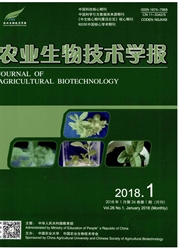

 中文摘要:
中文摘要:
为了探讨玉米苗期性状及其杂种优势形成的遗传学基础,以强优势玉米(Zea maysL.)杂交种组合豫玉22及其重组近交系为基础材料,采用三重测交(triple testcross,TTC)遗传交配设计,组配了包含312个测交后代的TTC群体,通过复合区间作图法检测到了30个控制发芽后第4天的最长根长、苗高、初生根数、根干重及叶干重的QTLs,并且在第2、3和7染色体上存在4个同时控制不同苗期性状的QTL区域。分析发现,在利用Z1和Z2数据定位出的22个QTLs中,以超显性位点最多(11个),加性(5个)和部分显性较少(5个),而显性最少(1个)。另外,还检测到8个QTLs与遗传背景之间的互作和16对不同标记间的互作。据此,我们提出超显性和上位性是玉米苗期性状及其杂种优势形成的主要遗传学基础。关键词玉米,苗期性状,三重测交,杂种优势,QTL定位
 英文摘要:
英文摘要:
To investigate the genetic basis of heterosis in maize seedling traits, highly heterotic maize(Zea mays L.) hybrid Yuyu22 and RILs(recombinant inbred lines) were used as basic population to construct TTC(triple testcross) population, which included 312 testcross progenies by using TTC genetic mating design. Thirty QTLs were detected for the longest root length(LRL), shoot height(SH), primary root number(RN), root dry matter weight(RDW) and shoot dry matter weight(LDW) by using composite interval mapping. And some QTLs for different seedling traits were found to be located on the same chromosome regions, and a total of 4 regions were detected, which distributed on chromosome 2, 3 and 7, respectively. Further analysis indicated that 22 QTLs were detected by using Z1 and Z2 data, which were classified as overdominant(11), additive(5), partially dominant(5) and dominant(1). Furthermore, 8 genome regions of QTL× genetic background interactions and 16 markers pairs with epistatic effects were detected. Collectively, we propose that overdominance and epistasis are the main genetic basis of maize seedling traits and their heterosis.
 同期刊论文项目
同期刊论文项目
 同项目期刊论文
同项目期刊论文
 Wheat (Triticum aestivum L.) root proteome and differentially expressed root proteins between hybrid
Wheat (Triticum aestivum L.) root proteome and differentially expressed root proteins between hybrid Molecular mapping of QTLs for root response to phosphorus deficiency at seedling stage in wheat (Tri
Molecular mapping of QTLs for root response to phosphorus deficiency at seedling stage in wheat (Tri Cloning and expression profiles of 15 genes encoding WRKY transcription factor in wheat (Triticum ae
Cloning and expression profiles of 15 genes encoding WRKY transcription factor in wheat (Triticum ae Identification of differentially expressed proteins between hybrid and parents in wheat (Triticum ae
Identification of differentially expressed proteins between hybrid and parents in wheat (Triticum ae The relationship of differential expression of genes in GA biosynthesis and response pathways with h
The relationship of differential expression of genes in GA biosynthesis and response pathways with h A novel histidine kinase gene, ZmHK9, mediate drought tolerance through the regulation of stomatal d
A novel histidine kinase gene, ZmHK9, mediate drought tolerance through the regulation of stomatal d Comparative Proteomic Analysis of Embryos between a Maize Hybrid and Its Parental Lines during Early
Comparative Proteomic Analysis of Embryos between a Maize Hybrid and Its Parental Lines during Early Expression and functional analysis of genes encoding cytokinin receptor-like histidine kinase in mai
Expression and functional analysis of genes encoding cytokinin receptor-like histidine kinase in mai Expression divergence of TaMBD2 homoeologous genes encoding methyl CpG-binding domain proteins in wh
Expression divergence of TaMBD2 homoeologous genes encoding methyl CpG-binding domain proteins in wh Epigenetic modification contributes to the expression divergence of three TaEXPA1 homoeologs in hexa
Epigenetic modification contributes to the expression divergence of three TaEXPA1 homoeologs in hexa Relationship of Photosynthetic Carbon Assimilation Related Traits of Flag Leaves with Yield Heterosi
Relationship of Photosynthetic Carbon Assimilation Related Traits of Flag Leaves with Yield Heterosi Overexpression of a wheat stearoyl-ACP desaturase (SACPD) gene TaSSI2 in Arabidopsis ssi2 mutant com
Overexpression of a wheat stearoyl-ACP desaturase (SACPD) gene TaSSI2 in Arabidopsis ssi2 mutant com Maize (Zea mays L.) seedling leaf nuclear proteome and differentially expressed proteins between a h
Maize (Zea mays L.) seedling leaf nuclear proteome and differentially expressed proteins between a h 期刊信息
期刊信息
